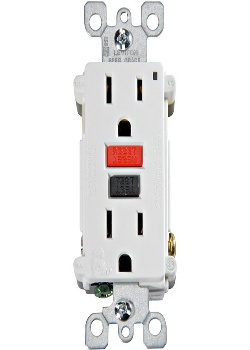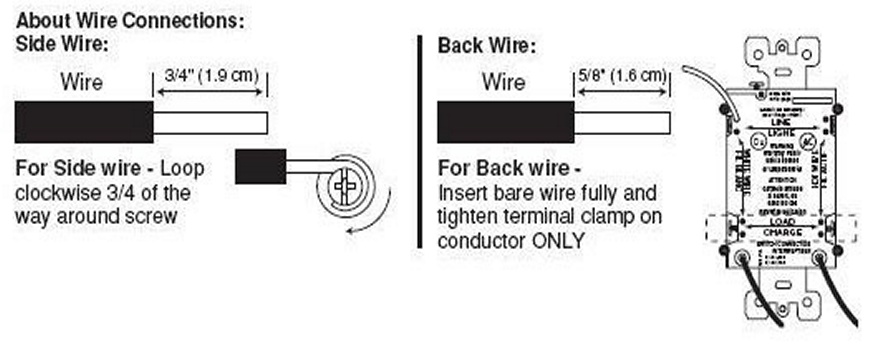|
|

















TRIPLE M LLC
Diagrams
GFCI Outlets
What is a GFCI?
A ground-fault circuit interrupter, or GFCI, is a device used in electrical wiring to
disconnect a circuit when unbalanced current is detected between an energized
conductor and a neutral return conductor. Such an imbalance is sometimes
caused by current "leaking" through a person who is simultaneously in contact
with a ground and an energized part of the circuit, which could result in lethal
shock. GFCIs are designed to provide protection in such a situation, unlike
standard circuit breakers, which guard against overloads, short circuits and
ground faults.
It is estimated that about 300 deaths by electrocution occur every year, so the use of GFCIs has been adopted in new construction, and recommended as an upgrade in older construction, in order to mitigate the possibility of injury or fatality from electric shock.
It is estimated that about 300 deaths by electrocution occur every year, so the use of GFCIs has been adopted in new construction, and recommended as an upgrade in older construction, in order to mitigate the possibility of injury or fatality from electric shock.
1. Turn Power OFF
2. Connect the Line Wire (Power or Hot wire) to the Line Terminals on the rear of the GFCI outlet.
Black (hot) wire to Brass/Gold colored screw
White (nuetral) wire to Silver colored screw
3. Connect the Load Wire (Wire to other outlets "downstream" of the GFCI) to the LOAD Terminals on the rear of the GFCI outlet. This will give Ground Fault protection for up to Four more outlets.
Black wire to Brass/Gold colored screw
White wire to Silver colored screw
4. Wire nut all Ground wires (bare copper) together with a pigtail about 6" long - Connect this pigtail to the grounding screw (green) on the GFCI outlet.
5. Fold all wire back into the box and attach outlet and cover plate.
6. Turn Power/breaker on and test GFCI outlet
2. Connect the Line Wire (Power or Hot wire) to the Line Terminals on the rear of the GFCI outlet.
Black (hot) wire to Brass/Gold colored screw
White (nuetral) wire to Silver colored screw
3. Connect the Load Wire (Wire to other outlets "downstream" of the GFCI) to the LOAD Terminals on the rear of the GFCI outlet. This will give Ground Fault protection for up to Four more outlets.
Black wire to Brass/Gold colored screw
White wire to Silver colored screw
4. Wire nut all Ground wires (bare copper) together with a pigtail about 6" long - Connect this pigtail to the grounding screw (green) on the GFCI outlet.
5. Fold all wire back into the box and attach outlet and cover plate.
6. Turn Power/breaker on and test GFCI outlet
Wiring a GFCI Outlet
Another method is wirenut all black wires together with pigtail, all white wires together with pigtail and all bare or ground wires
together with pigtail; then connect the pigtails to their respective terminal screws (black to brass, white to silver and ground/bare to
green. This method ONLY provides GFCI protection to the GFCI outlet itself. NO outlets "downstream" are protected.
The National Electrical Code (NEC) has included recommendations and requirements for GFCIs in some form since 1968,
when it first allowed for GFCIs as a method of protection for underwater swimming pool lights. Throughout the 1970s, GFCI
installation requirements were gradually added for 120-volt receptacles in areas prone to possible water contact, including
bathrooms, garages, and any receptacles located outdoors.
The 1980s saw additional requirements implemented. During this period, kitchens and basements were added as areas that were required to have GFCIs, as well as boat houses, commercial garages, and indoor pools and spas. New requirements during the '90s included crawlspaces, wet bars and rooftops. Elevator machine rooms, car tops and pits were also included at this time. In 1996, GFCIs were mandated for all temporary wiring for construction, remodeling, maintenance, repair, demolition and similar activities and, in 1999, the NEC extended GFCI requirements to carnivals, circuses and fairs.
The 2008 NEC contains additional updates relevant to GFCI use, as well as some exceptions for certain areas. The 2008 language is presented here for reference.
100.1 Definition
100.1 Definitions. Ground-Fault Circuit Interrupter. A device intended for the protection of personnel that functions to de-energize a circuit or portion thereof within an established period of time when a current to ground exceeds the values established for a Class A device.
FPN: Class A ground-fault circuit interrupters trip when the current to ground has a value in the range of 4 mA to 6 mA. For further information, see UL 943, standard for Ground-Fault Circuit Interrupters.
210.8(A)&(B) Protection for Personnel
210.8 Ground-Fault Circuit Interrupter Protection for Personnel.
(A) Dwelling Units. All 125-volt, single-phase, 15- and 20-ampere receptacles installed in the locations specified in (1) through (8) shall have ground-fault circuit-interrupter protection for personnel.
(1) bathrooms;
(2) garages, and also accessory buildings that have a floor located at or below grade level not intended as habitable rooms and limited to storage areas, work areas, and areas of similar use;
Exception No. 1: Receptacles not readily accessible.
Exception No. 2: A single receptacle or a duplex receptacle for two appliances that, in normal use, is not easily moved from one place to another and that is cord-and-plug connected in accordance with 400.7(A)(6), (A)(7), or (A)(8).
Receptacles installed under the exceptions to 210.8(A)(2) shall not be considered as meeting the requirements of 210.52(G)
(3) outdoors;
Exception: Receptacles that are not readily accessible and are supplied by a dedicated branch circuit for electric snow melting or deicing equipment shall be permitted to be installed in accordance with the applicable provisions of Article 426.
(4) crawlspaces at or below grade level;
(5) unfinished basements. For the purposes of this section, unfinished basements are defined as portions or areas of the basement not intended as habitable rooms and limited to storage areas, work areas, and the like;
Exception No. 1: Receptacles that are not readily accessible.
Exception No. 2: A single receptacle or a duplex receptacle for two appliances that, in normal use, is not easily moved from one place to another and that is cord-and-plug connected in accordance with 400.7(A)(6), (A)(7), or (A)(8).
Exception No. 3: A receptacle supplying only a permanently installed fire alarm or burglar alarm system shall not be required to have ground-fault circuit interrupter protection.
Receptacles installed under the exceptions to 210.8(A)(2) shall not be considered as meeting the requirements of 210.52(G)
(6) kitchens, where the receptacles are installed to serve the countertop surfaces;
(7) wet bar sinks, where the receptacles are installed to serve the countertop surfaces and are located within 6 feet (1.8 m) of the outside edge of the wet bar sink;
(8) boathouses;
(B) Other Than Dwelling Units. All 125-volt, single-phase, 15- and 20-ampere receptacles Installed in the locations specified in (1), (2), and (3) shall have ground-fault circuit interrupter protection for personnel:
(1) bathrooms;
(2) rooftops;
Exception: Receptacles that are not readily accessible and are supplied by a dedicated branch circuit for electric snow-melting or de-icing equipment shall be permitted to be installed in accordance with the applicable provisions of Article 426.
(3) kitchens.
The 1980s saw additional requirements implemented. During this period, kitchens and basements were added as areas that were required to have GFCIs, as well as boat houses, commercial garages, and indoor pools and spas. New requirements during the '90s included crawlspaces, wet bars and rooftops. Elevator machine rooms, car tops and pits were also included at this time. In 1996, GFCIs were mandated for all temporary wiring for construction, remodeling, maintenance, repair, demolition and similar activities and, in 1999, the NEC extended GFCI requirements to carnivals, circuses and fairs.
The 2008 NEC contains additional updates relevant to GFCI use, as well as some exceptions for certain areas. The 2008 language is presented here for reference.
100.1 Definition
100.1 Definitions. Ground-Fault Circuit Interrupter. A device intended for the protection of personnel that functions to de-energize a circuit or portion thereof within an established period of time when a current to ground exceeds the values established for a Class A device.
FPN: Class A ground-fault circuit interrupters trip when the current to ground has a value in the range of 4 mA to 6 mA. For further information, see UL 943, standard for Ground-Fault Circuit Interrupters.
210.8(A)&(B) Protection for Personnel
210.8 Ground-Fault Circuit Interrupter Protection for Personnel.
(A) Dwelling Units. All 125-volt, single-phase, 15- and 20-ampere receptacles installed in the locations specified in (1) through (8) shall have ground-fault circuit-interrupter protection for personnel.
(1) bathrooms;
(2) garages, and also accessory buildings that have a floor located at or below grade level not intended as habitable rooms and limited to storage areas, work areas, and areas of similar use;
Exception No. 1: Receptacles not readily accessible.
Exception No. 2: A single receptacle or a duplex receptacle for two appliances that, in normal use, is not easily moved from one place to another and that is cord-and-plug connected in accordance with 400.7(A)(6), (A)(7), or (A)(8).
Receptacles installed under the exceptions to 210.8(A)(2) shall not be considered as meeting the requirements of 210.52(G)
(3) outdoors;
Exception: Receptacles that are not readily accessible and are supplied by a dedicated branch circuit for electric snow melting or deicing equipment shall be permitted to be installed in accordance with the applicable provisions of Article 426.
(4) crawlspaces at or below grade level;
(5) unfinished basements. For the purposes of this section, unfinished basements are defined as portions or areas of the basement not intended as habitable rooms and limited to storage areas, work areas, and the like;
Exception No. 1: Receptacles that are not readily accessible.
Exception No. 2: A single receptacle or a duplex receptacle for two appliances that, in normal use, is not easily moved from one place to another and that is cord-and-plug connected in accordance with 400.7(A)(6), (A)(7), or (A)(8).
Exception No. 3: A receptacle supplying only a permanently installed fire alarm or burglar alarm system shall not be required to have ground-fault circuit interrupter protection.
Receptacles installed under the exceptions to 210.8(A)(2) shall not be considered as meeting the requirements of 210.52(G)
(6) kitchens, where the receptacles are installed to serve the countertop surfaces;
(7) wet bar sinks, where the receptacles are installed to serve the countertop surfaces and are located within 6 feet (1.8 m) of the outside edge of the wet bar sink;
(8) boathouses;
(B) Other Than Dwelling Units. All 125-volt, single-phase, 15- and 20-ampere receptacles Installed in the locations specified in (1), (2), and (3) shall have ground-fault circuit interrupter protection for personnel:
(1) bathrooms;
(2) rooftops;
Exception: Receptacles that are not readily accessible and are supplied by a dedicated branch circuit for electric snow-melting or de-icing equipment shall be permitted to be installed in accordance with the applicable provisions of Article 426.
(3) kitchens.
NEC Requirements for GFCIs